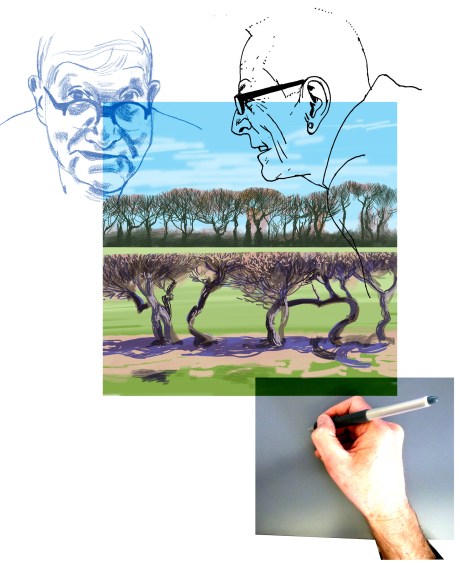In gold lamé jacket and matching shopping bag, bleached hair above black owl glasses, David Hockney strode across the page of The Sunday Times Colour Supplement, 1962. How cool! An explosion of colour to bring the 50’s to an end. A flamboyant, cheeky enfant terrible from the Royal College: an inspiration to a 15-year-old arty kid. Suddenly art was about personality, even showmanship, as well as the stuff on the canvas. But that stuff on the canvas was wonderful – a mixture of private desires writ large in big expressionistic brushstrokes, lettering and jokes, wry post-modern comments on the nature of painterly illusion. I loved the messy early paintings. And then I loved the tight flat acrylics from California, and especially his crayon drawings: I bought Caran D’Ache Prismalo crayons, and Schoellershammer paper.
There are many reasons why the English love David Hockney. His paintings are (generally) representational, colourful, and easy to understand. For all his years in California, he’s still got his Yorkshire accent, and he speaks engagingly, fluently, down-to-earth. And he projects his enthusiasm, for looking, for experimentation, for the world around him.
‘David Hockney RA: A Bigger Picture’ at the Royal Academy, fifty years on. It’s quite overwhelming, the sheer scale of his exhibition, filling these huge galleries, apart from the massive size of the paintings. His output is astonishing. You might say it’s about quantity, but the impact of the colour is thrilling. Vast canvases of the landscape of the Yorkshire Wolds – brilliant purples pinks bright greens – you get a sense of his joy in seeing and translating his vision. In the largest gallery there are 51 iPad drawings, drawn in the landscape, and they’re blown-up to about 7 feet high. It’s a joyful exhibition.
It’s an early spring day – blue sky, unseasonably warm, and Gill and I are following a walk from a laminated A5 sheet’s instructions, as in, ‘turn left along the edge of the field until you come to a stile…’. We started in Laughton, going north then round to the west and back down across the main road, towards the Laughton tower. In the bright sunlight there are the first traces of growth on the trees, and strong shadows, and it’s a Hockney landscape…

